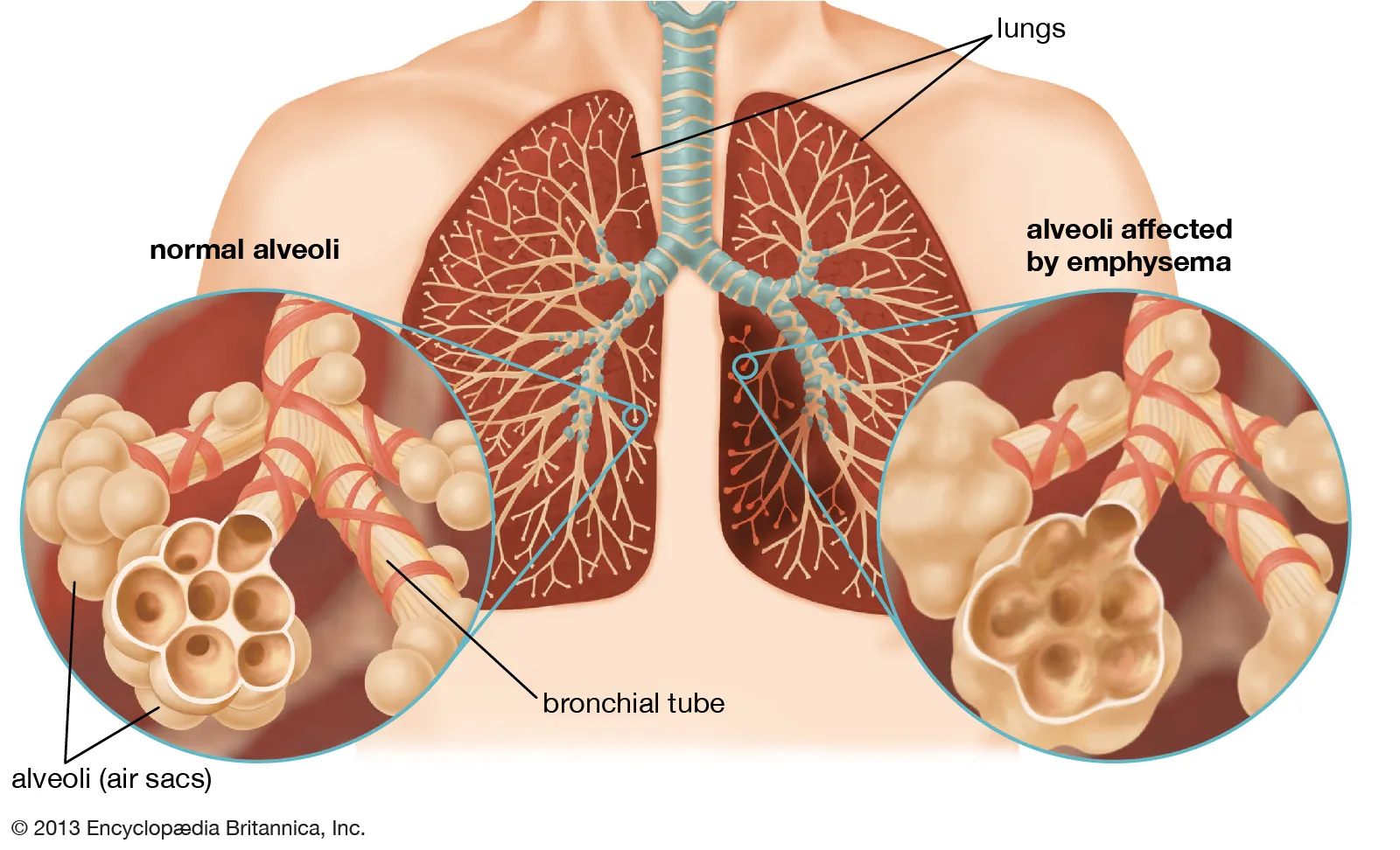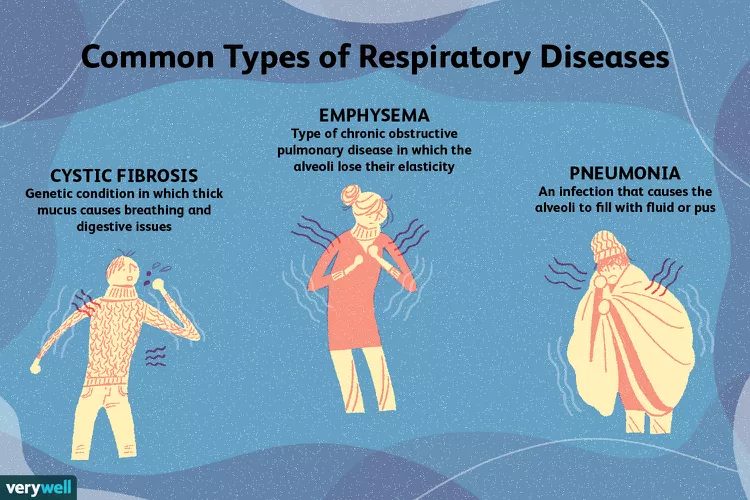The 8 Most Common Types of Respiratory Disease
The most common respiratory diseases are asthma, chronic obstructive pulmonary disease, cystic fibrosis, lung cancer, tuberculosis, bronchitis, pneumonia, and emphysema.

Respiratory disease | Definition, Causes, & Major Types | Britannica
Some respiratory diseases are acute, like an infection that will get better with treatment, while others are or become chronic and need to be managed.
Many types of lung diseases can cause chronic respiratory conditions. Chronic respiratory disease affects millions of people in the United States alone. It can be difficult to say how many people have lung diseases overall because these diseases are grouped into specific conditions.
Many genetic and environmental factors can lead to lung disease, but smoking is the top preventable cause of many respiratory conditions.
This article will look at the eight most common respiratory diseases, their symptoms, and what causes them.

Common Types of Respiratory Diseases
Asthma
Asthma affects 25 million people in the United States. People with a family history of asthma, respiratory allergies, or severe childhood respiratory illness are at a higher risk of developing asthma.
Asthma is a chronic inflammatory disease that causes breathing problems when the airways become narrowed by inflammation or blocked by mucus. The condition’s severity varies from person to person, but most people take daily preventive medication to control their symptoms and prevent flare-ups.
Symptoms
Asthma can have several symptoms, including:
- Wheezing
- Coughing
- Tightness in the chest
- Shortness of breath
Chronic Obstructive Pulmonary Disease (COPD)
Chronic obstructive pulmonary disease (COPD) is an umbrella term used to describe two primary types of obstructive lung disease that used to be classified separately: emphysema and chronic bronchitis.2
- Emphysema develops when the tiny air sacs in the lungs (alveoli) become damaged and less elastic. This reduces the ability of the sacs to move oxygen and other gases between the air that is breathed in and the blood. This can lead to a lack of oxygen in the blood (hypoxia) and a buildup of toxic waste products.
- Chronic bronchitis is a condition where the lining of the bronchial tubes becomes irritated and inflamed. The swelling can make it more difficult to breathe and cause an overproduction of mucus.
Nearly 15 million people have been diagnosed with COPD in the United States, and another 12 million are believed to have the disease but do not have an official diagnosis.
COPD is the fourth leading cause of death in the United States. About eight in 10 cases are linked to exposure to cigarette smoke.
Symptoms
The symptoms of COPD vary based on which type you have. Common symptoms can include:
- A frequent or chronic cough
- A cough that produces a lot of mucus
- Wheezing
- A squeaking or whistling sound when you breathe
- Shortness of breath that is worse with activity
- Tightness in your chest
- Sensitivity to respiratory infections like colds or the flu
- Weight loss
- Weakness
- Swelling in your legs and feet
- A blue tinge to your lips or fingernails (cyanosis)
Cystic Fibrosis
Cystic fibrosis (CF) is a genetic condition that affects about 35,000 people in the United States. It can cause both breathing and digestive problems because the disease makes the mucus in the body very thick.
While the disease can involve several organs, it tends to cause specific problems in the lungs, such as blockages from thick mucus that trap harmful bacteria and lead to infections.
A diagnosis of CF is usually made early in life because newborns in the United States are screened for the disease. If a diagnosis is not made at birth, symptoms that occur in childhood can lead to the diagnosis later on.
Symptoms
Since cystic fibrosis can affect many parts of the body, a wide range of symptoms can develop, such as:
- A cough that does not go away
- A cough that produces thick mucus or blood
- Wheezing
- Shortness of breath
- Frequent respiratory or sinus infections
- Nasal polyps
- Slow growth in childhood or poor weight gain
- Constipation
- Greasy or foul-smelling stools
Lung Cancer
Lung cancer is one of the most common types of cancer, ranking third in the United States with more than 218,000 people affected.4 It can develop as either small cell lung cancer or non-small cell lung cancer, which is the more common of the two.
Cigarette smoking—both direct and secondhand—is one of the biggest risk factors for lung cancer.
Symptoms
Lung cancer can develop gradually and often with no symptoms. When it does appear, symptoms may include:
- Chest pain
- Chronic cough
- Difficulty breathing
- Wheezing
- Hoarseness
- Weight loss
- Fatigue or weakness
- Difficulty swallowing
- A cough that produces bloody mucus
- Swelling in the face or neck
Tuberculosis
Tuberculosis is a bacterial lung disease caused by Mycobacterium tuberculosis. More than 1.8 billion people around the world have tuberculosis, but the disease is only considered active in 10 million of them.
People with strong immune systems sometimes carry an inactive form of the disease, called latent tuberculosis. In people with weaker immune systems, the bacteria attacks lung tissue. It can also spread and cause damage to other parts of the body.
Symptoms
Many respiratory diseases share symptoms, such as long-term cough. Certain symptoms are specific to one disease or another. For example, night sweats tend to occur in people with tuberculosis.
Other tuberculosis symptoms include:
- A cough that lasts longer than three weeks
- Weight loss
- Poor appetite
- A cough that brings up blood or mucus
- Weakness
- Fatigue
- Fever
- Night sweats
Bronchitis
Bronchitis is a condition that develops when the windpipe (bronchial tube) gets irritated or inflamed. In response to the inflammation, the lining of the bronchial tube may make too much mucus as it tries to coat the area. The mucus can make it difficult to breath.
Inflammation can also cause swelling of the airway. This will cause it to narrow and makes it harder to breathe.
Bronchitis can be acute or chronic. There are some key differences between the two forms:
- In acute bronchitis, the inflammation is usually caused by an infection that will get better in a few days to several weeks.
- With chronic bronchitis, the inflammation is caused by repeated exposure to irritants—like cigarette smoke or pollution. Chronic bronchitis does not go away. You may have periods of relief along with periods where it gets worse (exacerbations), especially if you get a cold or another respiratory infection
Symptoms
Chronic bronchitis falls under the umbrella of COPD. Acute bronchitis is not considered COPD, but it shares symptoms with the chronic form of the disease. These symptoms include:
- A frequent cough that produces mucus
- Wheezing
- A whistling or squeaking sound when you breathe
- Shortness of breath (especially with activity)
- Tightness in your chest
- Fever (acute bronchitis only)
Pneumonia
Pneumonia is a generic diagnosis. Even though there are different types of pneumonia, the way that the condition affects the lungs is similar in each one.
With pneumonia, a virus, bacteria, or another infectious agent causes the tiny air sacs in the lungs (alveoli) to fill with fluid or pus. These air sacs are what help exchange oxygen and other gases between the air that is breathed in and the blood. When these sacs are filled with fluid, the body’s ability to exchange gases is reduced.
The several types of pneumonia are:
- Viral
- Bacterial
- Mycoplasma (also called “walking pneumonia”)
- Fungal
- Aspiration
Symptoms
In some types of pneumonia, such as walking pneumonia, the symptoms can be mild and not affect daily activities. However, the symptoms of pneumonia can be severe and, in some cases, will require hospitalization.
Common symptoms of pneumonia are:
- Fever
- Chills
- A cough that produces phlegm
- Shortness of breath
- Chest pain when you cough or breathe
- Nausea
- Vomiting
- Diarrhea
Summary
There are several types of lung diseases that can affect your breathing and cause chronic symptoms like cough. Many of these diseases share symptoms.
If you have a cough that won’t go away or you are experiencing frequent shortness of breath, call your doctor. They can do testing to confirm what type of lung disease is causing your respiratory problems and may refer you to a doctor that specifically treats lung disease (pulmonologist).
The articles on this website are for reference only and do not replace medical diagnosis or treatment. Please do not follow them on your own
Make a question

If you have any questions, please contact us via contact information, or fill in the form below.
Schedule a consultation appointment with the doctor
Before you leave, leave your information so we can send you medical news that may be of interest to you..

The doctor does not have an appointment scheduled, please choose another day

Note: The appointment time is only approximate, T-Matsouka will contact to confirm with customers after receiving the examination schedule information. Thank you for waiting for a response from T-Matsuoka.






Star rating:
Sort by :
No reviews yet.